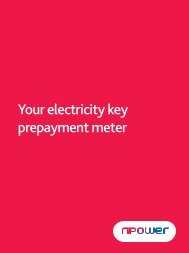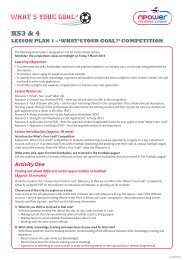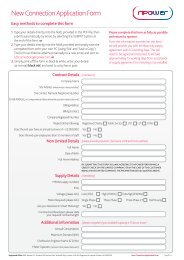Your npower home energy monitor
Your npower home energy monitor
Your npower home energy monitor
You also want an ePaper? Increase the reach of your titles
YUMPU automatically turns print PDFs into web optimized ePapers that Google loves.
<strong>Your</strong> questions answered<br />
Q. If I remove the batteries will I lose the information on the display unit<br />
A. The display unit has an internal memory, so information stored on it won’t be lost<br />
if you need to change or remove the batteries.<br />
Q. How do I reset the display (clear the data and start again)<br />
A. To reset the unit press and hold the Up p and Down q buttons and then remove<br />
and re-insert the power cord into the back of the display, whilst keeping the buttons<br />
pressed for 3 seconds.<br />
Q. How much electricity does the <strong>npower</strong> <strong>home</strong> <strong>energy</strong> <strong>monitor</strong> use<br />
A. The display uses less then 12 watt hours (or approximately 1.2p) a month to run<br />
– that’s less than making a single piece of toast!<br />
Q. Why does the display show a different reading to my electricity bill<br />
A. The <strong>npower</strong> <strong>home</strong> <strong>energy</strong> <strong>monitor</strong> is a good indicator of your approximate electricity<br />
consumption, but it’s only intended as a guide. The sensor doesn’t communicate with<br />
your meter directly and won’t send your readings to your supplier. If your supplier asks<br />
for a reading or if you’re checking your bills, always look at the readings on your meter<br />
(NOT your <strong>npower</strong> <strong>home</strong> <strong>energy</strong> <strong>monitor</strong>) as these will continue to be used for<br />
billing purposes.<br />
Q. Where do I find my tariff information<br />
A. You can find tariff information on your electricity bill.<br />
Q. What target consumption should I set<br />
A. The target consumption is best set by working out your daily average from your most<br />
recent electricity bill.<br />
Q. My tariff has a standing charge. How should I calculate my tariff<br />
A. Don’t include your standing charge in the calculation of the tariff. <strong>Your</strong> bill will include<br />
a unit rate shown in pence per kWh. Just remember when you’re looking at your<br />
<strong>energy</strong> costs that you’ll also be paying the standing charge each day, no matter how<br />
much electricity you use.<br />
Q. I have a tariff with two different unit rates, a higher rate for the first units I use<br />
and a lower rate for the rest. How do I calculate my average electricity unit rate<br />
to enter a tariff<br />
A. Take the total price paid for your first units of electricity, plus the total price paid for<br />
the rest of your units, and divide by the total units.<br />
For example, 200 units at £0.20 and 50 units at £0.10 would work out as follows:<br />
(200 x £0.20) + (50 x £0.10) = (£40 + £5) or £45 for 250 units = £0.18 per unit<br />
<strong>Your</strong> <strong>npower</strong> <strong>home</strong> <strong>energy</strong> <strong>monitor</strong> is<br />
manufactured and supplied to <strong>npower</strong> by<br />
GEO - Green Energy Options<br />
Technical support is provided by Green Energy Options (GEO), the third party<br />
manufacturer of your <strong>npower</strong> <strong>home</strong> <strong>energy</strong> <strong>monitor</strong>. GEO is responsible for the quality<br />
and fitness for purpose of your <strong>energy</strong> <strong>monitor</strong> and for all subsequent service/product<br />
related enquiries. As a result, <strong>npower</strong> shall have no liability or responsibility in respect of<br />
the same.<br />
Copyright © 2009 Npower Limited. All rights reserved.<br />
Green Energy Options Limited (GEO) and <strong>npower</strong> make no representations and give no warranties of any kind in relation<br />
to the contents of this document and all warranties, conditions and other terms implied by statute or common law are, to<br />
the fullest extent permitted by law, hereby excluded.<br />
In particular, GEO and <strong>npower</strong> assume no responsibility for any errors or omissions that may appear in this document and<br />
make no commitment to either update or keep current the information contained in this document.<br />
GEO and <strong>npower</strong> retain the right to make changes to this document (including any specifications contained herein) at any<br />
time without notice.<br />
No part of this document may be modified, copied, reproduced, republished, published, transmitted or distributed in any<br />
form or by any means without the prior written consent of <strong>npower</strong>. The contents of this document are to be used solely<br />
for the purpose for which they are provided by <strong>npower</strong> and for no other purpose. All content, text, graphics and all other<br />
materials contained in this document are owned by <strong>npower</strong> (or its licensors), and all proprietary and intellectual property<br />
rights (including copyright, design rights, trade secrets, trade names, logos and trade marks) wherever arising in relation to<br />
this document vest in <strong>npower</strong> (or its licensors) and all such rights are reserved.<br />
GEO confirms that the <strong>npower</strong> <strong>home</strong> <strong>energy</strong> <strong>monitor</strong> conforms to the following standards:<br />
EN300 220-1 v1.3.1 Radio Device RF Performance (UK & Europe), SRD Category 2<br />
EN301 489-3 Emissions EMC (UK & Europe)<br />
EN61010-1 Safety Requirements (UK & Europe)<br />
EN60950 Safety Requirements (UK & Europe)<br />
CE UK standards<br />
Cat III Max Voltage 264 Vac<br />
Max Current 75A<br />
Model Monitor Display (PD-01) Monitor Transmitter (PT-01) Monitor Sensor (MS-01)<br />
Rated voltage 230 Vac 50Hz 3 x AA 1.5V batteries N/A<br />
Input power 0.25W 0.2W N/A<br />
Operation 0 to 40ºC -20 to 50ºC -20 to 50ºC<br />
Humidity 85% non-condensing 85% non-condensing 85% non-condensing<br />
18<br />
19

















